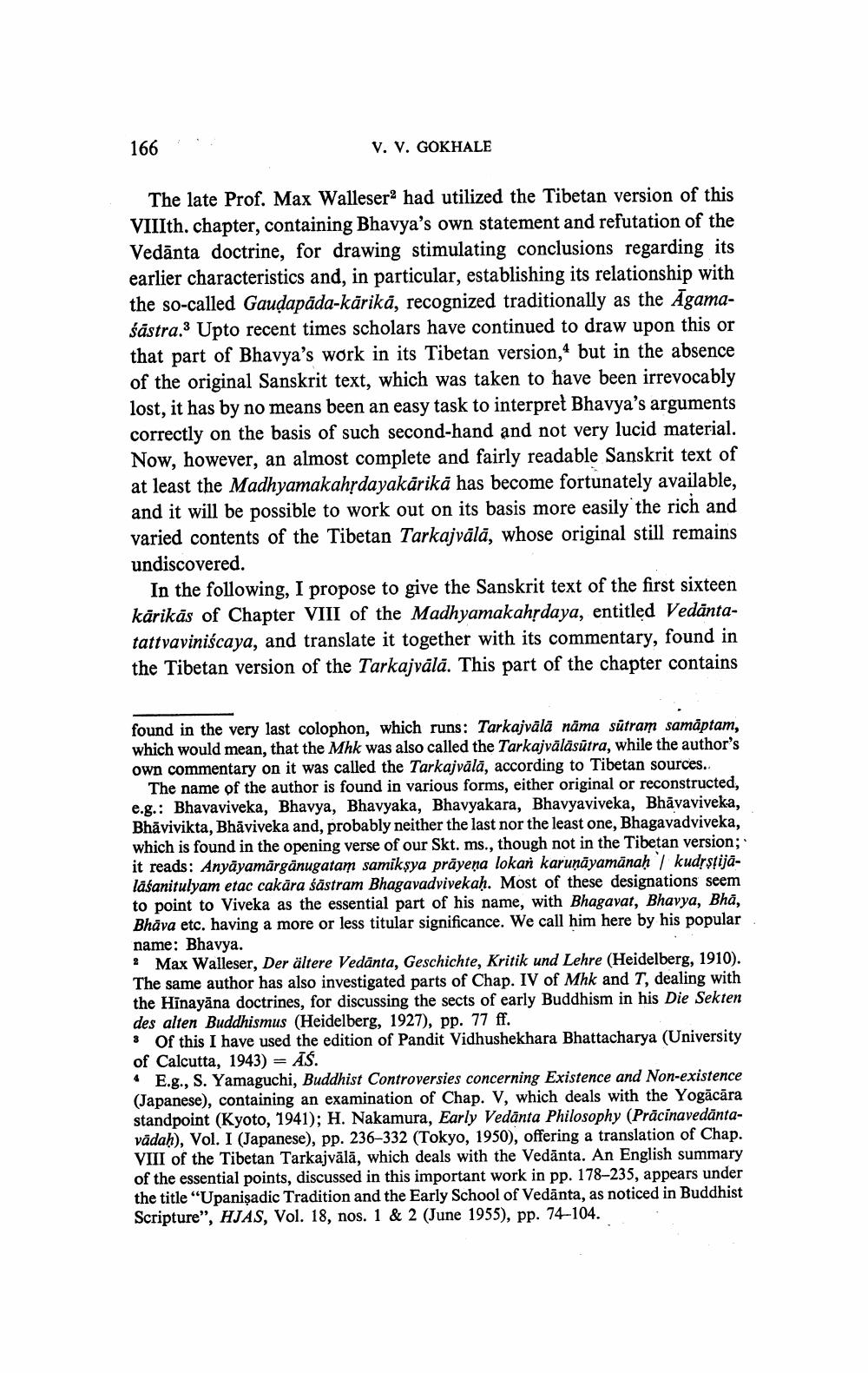________________
166
V. V. GOKHALE
The late Prof. Max Walleser had utilized the Tibetan version of this VIIIth. chapter, containing Bhavya's own statement and refutation of the Vedānta doctrine, for drawing stimulating conclusions regarding its earlier characteristics and, in particular, establishing its relationship with the so-called Gaudapāda-kārika, recognized traditionally as the Agamaśästra.3 Upto recent times scholars have continued to draw upon this or that part of Bhavya's work in its Tibetan version, but in the absence of the original Sanskrit text, which was taken to have been irrevocably lost, it has by no means been an easy task to interpret Bhavya's arguments correctly on the basis of such second-hand and not very lucid material. Now, however, an almost complete and fairly readable Sanskrit text of at least the Madhyamakahrdayakārika has become fortunately available, and it will be possible to work out on its basis more easily the rich and varied contents of the Tibetan Tarkajvälā, whose original still remains undiscovered.
In the following, I propose to give the Sanskrit text of the first sixteen kārikās of Chapter VIII of the Madhyamakahrdaya, entitled Vedāntatattvaviniscaya, and translate it together with its commentary, found in the Tibetan version of the Tarkajvälā. This part of the chapter contains
found in the very last colophon, which runs: Tarkajvālā nāma sūtram samāptam, which would mean, that the Mhk was also called the Tarkajvālāsūtra, while the author's own commentary on it was called the Tarkajvālā, according to Tibetan sources..
The name of the author is found in various forms, either original or reconstructed, e.g.: Bhavaviveka, Bhavya, Bhavyaka, Bhavyakara, Bhavyaviveka, Bhāvaviveka, Bhăvivikta, Bhăviveka and, probably neither the last nor the least one, Bhagavadviveka, which is found in the opening verse of our Skt. ms., though not in the Tibetan version; it reads: Anyāyamārgānugatam samiksya prāyeņa lokan karunāyamanah / kudrslijālaśanitulyam etac cakära sästram Bhagavadvivekah. Most of these designations seem to point to Viveka as the essential part of his name, with Bhagavat, Bhavya, Bhā, Bhāva etc. having a more or less titular significance. We call him here by his popular name: Bhavya. 2 Max Walleser, Der ältere Vedānta, Geschichte, Kritik und Lehre (Heidelberg, 1910). The same author has also investigated parts of Chap. IV of Mhk and T, dealing with the Hinayāna doctrines, for discussing the sects of early Buddhism in his Die Sekten des alten Buddhismus (Heidelberg, 1927), pp. 77 ff. 3 Of this I have used the edition of Pandit Vidhushekhara Bhattacharya (University of Calcutta, 1943) = ĀS. • E.g., S. Yamaguchi, Buddhist Controversies concerning Existence and Non-existence (Japanese), containing an examination of Chap. V, which deals with the Yogācāra standpoint (Kyoto, 1941); H. Nakamura, Early Vedānta Philosophy (Prācīnavedāntavādaḥ), Vol. I (Japanese), pp. 236-332 (Tokyo, 1950), offering a translation of Chap. VIII of the Tibetan Tarkajvālā, which deals with the Vedānta. An English summary of the essential points, discussed in this important work in pp. 178-235, appears under the title "Upanişadic Tradition and the Early School of Vedānta, as noticed in Buddhist Scripture", HJAS, Vol. 18, nos. 1 & 2 (June 1955), pp. 74-104.




